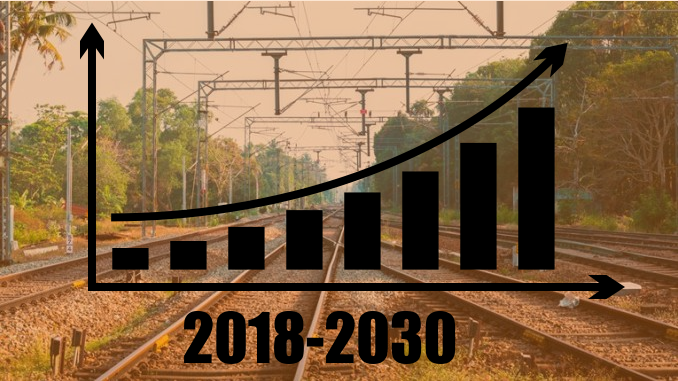
In the Union Budget 2019-20, it was estimated that an investment of Rs 50 lakh crores would be needed for railway infrastructure between 2018-2030. Railway projects are not conceived/executed on State/Union Territory basis.
Investment in Railways is mobilized from a mix of sources including budgetary and extra budgetary resources through institutional finance and Public Private Partnership (PPP). A part of investment in the area of completion of tracks, rolling stock manufacturing and delivery of passenger/freight services is envisaged through PPP.
Projects taken up by the Indian Railways:
1. ‘Adarsh’ Station Scheme:
Around 1250 stations have been identified for upgradation under Adarsh Railway Station Development Scheme across all the states.
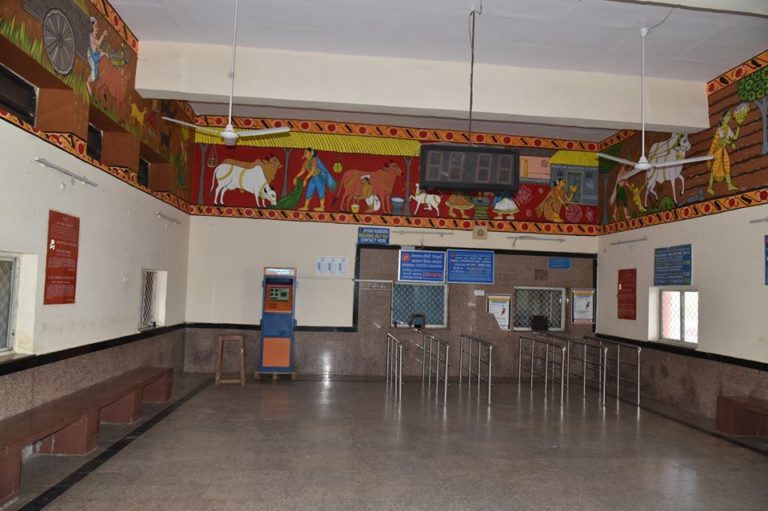
‘Adarsh’ Station Scheme has been started since 2009-10 and presently, upgradation of Railway stations are taken under ‘Adarsh Station Scheme’. Since then, 1253 stations have been identified for development under ‘Adarsh Station Scheme’ out of which 1149 stations so far have been developed under ‘Adarsh Station Scheme’ and remaining stations are targeted to be developed by 2019-20.
Various passenger amenities which, inter-alia, include improvement to façade of the station building, retiring room, waiting room (with bathing facilities), separate waiting room for ladies, landscaping of circulating area, earmarked parking, signages, Pay & Use toilets, Foot Over Bridge, ramps at entry to station etc. are proposed to be provided at Railway stations which are identified for development under this scheme as per the respective category of the station and the works for which are funded under Plan Head ‘Passenger Amenities’.
Upgradation / modernization of stations on Indian Railways is a continuous and on-going process. Works for improvement of passenger amenities are undertaken depending upon need, volume of passenger traffic and inter-se priority, subject to availability of funds.
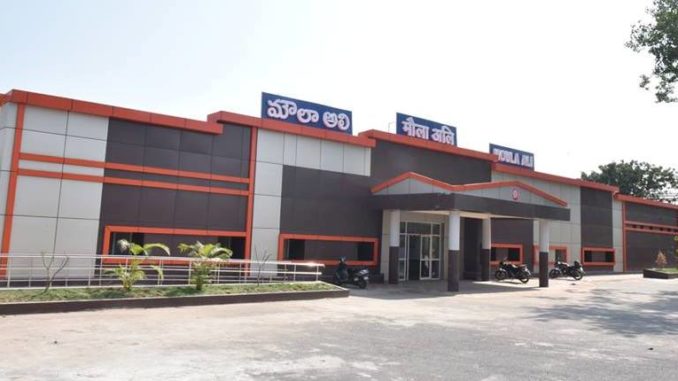
Funds are not allocated separately for Adarsh Station Scheme and the works are carried out under various passenger amenities works under Plan Head–53 ‘Passenger Amenities’. The details of funds allocated under Budgetary Sources for this Plan Head-53, over Indian Railways during the last three years namely 2016-17, 2017-18 and 2018-19 and current year are as under:
| YEARS | ALLOCATION |
| 2016-17 | Rs 917.91 crs. |
| 2017-18 | Rs 1470.79 crs. |
| 2018-19 | Rs 2410.71 crs. |
| 2019-20 | Rs 3422.57 crs. |
2. Environmental friendly technologies:
- Use of Renewable Energy i.e. Solar Power and Wind Power – At present Indian Railways (IR) utilizes about 202 megawatt (MW) of renewable power.
- Provision of energy efficient Light Emitting Diode (LED) lighting – 100% railway stations, service buildings and about 89% of residential quarters have been provided with LED lights.
- Provision of Bio-toilets in coaches- Nearly 2,30,000 Bio-toilets have been installed in 64,000 passenger coaches.
- Blending Bio-Diesel with High Speed Diesel (HSD) – Blending of 5% Bio-Diesel in HSD for diesel locomotive was started in June, 2015
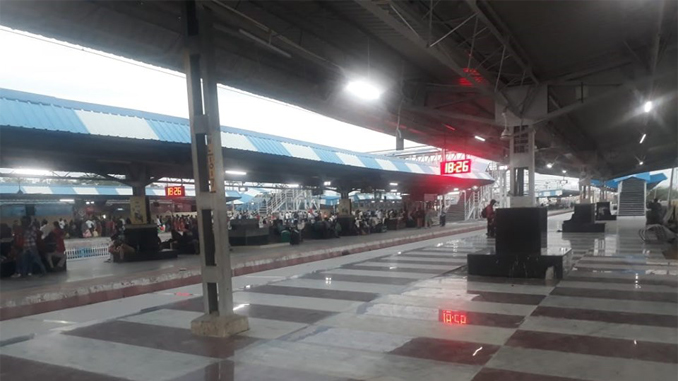
3. New Railway projects:
At present 498 Railway projects including 188 New Lines, 55 Gauge Conversion and 255 Doubling Projects are in different stages of execution/planning/sanction. The total length of these projects is 49,069 km costing Rs 6.75 Lakh Crore.
Above projects include:-
- 188 New Line Projects of length 21,295 km, costing Rs.3.87 lakh crore, out of which, commissioning of 2,622 km has been achieved and expenditure of Rs.85,536 crore incurred up to March, 2019.
- 55 Gauge Conversion Projects of length 7,275 km, costing Rs.56,135 crore, out of which, commissioning of 3,573 km has been achieved and expenditure of Rs.19,640 crore incurred up to March, 2019.
- 255 Doubling Projects of length 20,500 km, costing Rs.2.32 lakh crore, out of which, commissioning of 2,784 km has been achieved and expenditure of Rs.48,342 crore incurred up to March, 2019.
The average annual expenditure in New line/Gauge Conversion/Doubling Projects in 2009-14 was Rs.11527 crore, which increased to Rs.26,022 crore, during 2014-19, which is 126% more of average of 2009-2014.

Further, allocation of Budget for 2019-2020 is Rs.30,198 crore, which is, 162% more with respect to average annual budget outlay of 2009-14.
The timely completion of any Railway project depends on various factors like quick land acquisition by State Government, forest clearance by officials of forest department, shifting of infringing utilities (both underground and over ground), statutory clearances from various authorities, geological and topographical conditions of area, law and order situation in the area of project site, number of working months in a year for particular project site due to climatic considerations, encountering unforeseen conditions like earthquake, flooding, excessive rains, strikes of labour, orders of Hon’ble Courts, situation and conditions of working agencies/contractors etc. All these factors vary from project to project and site to site and affect the completion time and cost of the project, which is finally worked out at the completion stage.
In the overall interest of the nation and to ensure that projects are completed in time without cost overrun, lot of monitoring is done in Railways at various levels (field level, divisional level, zonal level and Board level) and regular meetings are held with the officials of State Government and concerned authorities to resolve the pending issues that are obstructing the progress of projects.
To ensure that projects are completed even before time, Railway has adopted the concept of incentives to the contractor in the form of bonus clause in contracts which will further enhance the pace of execution of projects. For capacity enhancement projects, etc. institutional financing has been done by arranging loan of Rs 1.5 lakh crore, which has increased Railways’ capacity for committed fund provision for essential projects.
4. Automatic Train Protection System:
The Indian Railways is planning to cover its entire network of 68,000 route km with the Automatic Train Protection (ATP) system in a phased manner. As a pilot project, the system would be implemented on 650 route km of the golden quadrilateral corridor connecting the four metros – Delhi, Mumbai, Chennai and Kolkata.

Automatic Train Protection system (ETCS Level-2) has been included in the Works Programme 2018-19 for implementation for complete 60,000 RKMs on Broad Gauge network of Indian Railways subject to expenditure on this project to be made only after following due processes/mandatory approvals and sanctions.
This will provide technological aid to Loco Pilots for avoiding Signal Passing at Danger (SPAD) and over speeding.
5. Redevelopment of Other Railway Stations:
Ministry of Railways have planned for redevelopment of railway stations through Indian Railway Stations Development Corporation Limited (IRSDC), Rail Land Development Authority (RLDA) and other Central Government agencies. All major stations on Indian Railways have been entrusted to these agencies for undertaking the techno-economic feasibility studies. Based on the outcome of the feasibility studies the stations are planned to be taken up for redevelopment, in phases.
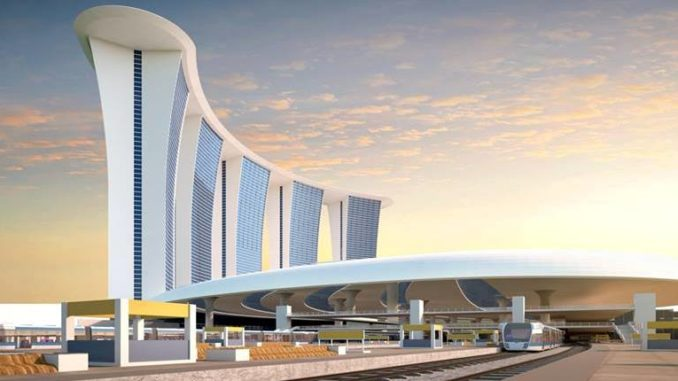
The Union Cabinet chaired by Prime Minister Shri Narendra Modi has approved the redevelopment of Railway Stations by Indian Railway Stations Development Corporation Limited (IRSDC) as Nodal Agency and main Project Development Agency, through simplified procedures adapting various business model and for longer lease tenure of upto 99 years. Thus, paving the way for large scale modernisation and ensure world class infrastructure.
Redevelopment of stations is planned through leveraging commercial development of vacant land and air space in and around railway stations, i.e. station redevelopment projects shall generally be cost neutral to Railways.
Works for redevelopment of Habibganj (Bhopal) and Gandhinagar stations are in progress and is expected to be completed by March 2020. Ministry of Railways is redeveloping Bhubaneshwar Station in cooperation with Govt of Odisha.
Following 23 stations were taken up for bidding in first phase: –
| S. No. | Name of Station | State
| S. No. | Name of station | State |
| 1 | LokmanyaTilak (T) | Maharashtra | 13 | Faridabad | Haryana |
| 2 | Pune | Maharashtra | 14 | Jammu Tawi | Jammu & Kashmir |
| 3 | Thane | Maharashtra | 15 | Secunderabad | Andhra Pradesh |
| 4 | Mumbai Central | Maharashtra | 16 | Vijayawada | Andhra Pradesh |
| 5 | Bandra Terminus | Maharashtra | 17 | Ranchi | Jharkhand |
| 6 | Borivali | Maharashtra | 18 | Chennai Central | Tamil Nadu |
| 7 | Howrah | West Bengal | 19 | Kozhikode | Kerala |
| 8 | Visakhapatnam | Andhra Pradesh | 20 | Yashwantpur | Karnataka |
| 9 | Kanpur Central | Uttar Pradesh | 21 | Bangalore Cantt | Karnataka |
| 10 | Allahabad | Uttar Pradesh | 22 | Indore | Madhya Pradesh |
| 11 | Kamakhya | Assam | 23 | Bhopal | Madhya Pradesh |
| 12 | Udaipur City | Rajasthan |
The phase is expected to be of approximately Rs 6000 -9,000 Crore in size. Railway Board has devised an innovative plan to provide these amenities through PPP model by leveraging the real estate available at the railway stations. IRSDC is taking up redevelopment of around 600 major Railway stations across the country.

With an overall size of more than 1 lakh crore, the program is one of the largest PPP program undertaken in the country.
The facilities proposed in a redeveloped station include congestion free non-conflicting entry/exit to the station premises, segregation of arrival/departure of passengers, adequate concourse without overcrowding, integration of both sides of the city wherever feasible, integration with other modes of transport systems e.g. Bus, Metro, etc., user friendly international signage, well illuminated circulating area and sufficient provision for drop off, pick up & parking etc.
RLDA has also entered into an MoU with Massouri Dehradun Development Authority (MDDA) for redevelopment of Dehradun Railway Station. Rail Land Development Authority (RLDA) has signed an MoU with National Highway Authority of India in April-2019, for redevelopment of Ajni (Nagpur) station as a Multi-modal Hub. Station redevelopment program is first of its kind and complex in nature and requires detailed techno-financial feasibility studies and various statutory clearances from local bodies etc.
6. Solar Panels on Railway Stations:
Indian Railways has plans to provide 500 MW rooftop solar plants by 2021-22. Most of this work is being done in Public Private Partnership (PPP) mode (Developer mode) by private partners, in which Railways do not have to incur capital expenditure. Work of provision of Solar panels on trains is also being done by private partners.
Indian Railways plans to install solar energy panels in other stations depending upon site availability and feasibility. So far, tenders for 248.46 MW capacity have been awarded by Railway Energy Management Company Limited (REMCL) and are under different stages of execution. This will cover the rooftops of Railway station platforms shelters and various other Railway buildings.

So far 95.67 Mega Watt (MW) of Rooftop Solar Power has been installed on various Railway buildings, including 835 Railway stations.
7. Semi High Speed Projects:
The Indian Railways will implement a Rs 18,000-crore project to operate trains at a speed of 160 kmph on the busy Delhi-Mumbai and Delhi-Kolkata routes by upgrading infrastructure.
The Indian Railways’s target is to operate high speed trains in two categories — at 160 kmph on the Delhi-Mumbai and Delhi-Kolkata routes, and up to 320 kmph under the ongoing bullet train project between Mumbai-Ahmedabad. Currently, the average maximum speed of trains on various routes is 99 kmph and the recently introduced Delhi-Varanasi Vande Bharat Express touches an average speed of 104 kmph on the Delhi-Kanpur section.
In August this year, the Government has given its approval for increasing the speed of the Delhi-Howrah route (including Kanpur-Lucknow) to 160 Kmph’ at a total cost of Rs. 6,685 cr by 2022-23. This will ensure improved speed, service, safety and create capacity. As part of Mission Raftaar, Indian Railways is working in mission mode to improve the average speed of trains across the network. Increasing the speed of the Delhi-Howrah Section to 160 Kmph will ensure upto 60% increase in average speed of passenger trains and doubling of average speed of freight traffic.

The 1,525 Kms long Delhi-Howrah Route passes through 5 states, namely Delhi, Uttar Pradesh, Bihar, Jharkhand, and West Bengal. The travel time between New Delhi and Howrah will be reduced by 5 hours, now making it a fully overnight journey. Increasing the maximum speed of the Delhi-Howrah route will also give further impetus to semi-high speed trains like the Vande Bharat Express. It will allow such trains to unlock their full potential and travel at a speed of 160 Kmph, to ensure passengers have best in class speed and service. In addition, it has been found that the safer LHB coaches too can be made fit for this speed.
The scope of the project includes fencing, Automatic Train Protection System (ETCS 2/TPWS), Mobile Train Radio Communication, and automated and mechanised diagnostic systems, which will considerably enhance safety and reliability. Besides the above main inputs, the policy also requires removal of all level crossings which are being eliminated otherwise under a separate plan head.
The entire project has been structured on a new approach of route wise single composite work with single agency execution, and complete funding through Extra Budgetary Resources – Institutional Finance (ERB-IF). With improved funding, better coordination, economies of scale, and induction of state of the art technology, the project will be completed in 4 years from the date of approval. Furthermore, work along the line will be planned with minimum disruption of traffic, ensuring passengers and businesses are least affected during the construction phase.

The project will help boost employment during the construction phase with more than 3.6 crore mandays to be generated directly. It will also help kick start an economic multiplier that will give a boost to growth in all states. The project will also lead to an increase in throughput on the route by 30-35%, paving the way for PPP models in the future.
As a part of Mission Raftaar, Government has also granted similar approval for the Delhi-Mumbai route, which together with the Delhi-Howrah route account for 29% of passenger traffic and 20% of freight traffic. Railways is also working to cover the complete Golden Quadrilateral and Diagonals of Indian Railways, which consist of 16% of the total Indian Railways Network, but account for 52% of total passenger traffic and 58% of total freight traffic.
8. Reconstruction/Strengthening of Railway Bridges:
Indian Railways has sanctioned 4,168 bridges for repair and strengthening this year at an estimated cost of Rs 809 crore.
As on 01.04.2019, there are 1,50,746 Railway Bridges on Indian Railways’ network. There is a well-established system of inspection of railway bridges in Indian Railways. All the bridges are inspected twice a year, one before the onset of monsoon and one detailed inspection after the monsoon by the designated officials. Repair / strengthening / rehabilitation / rebuilding of railway bridges is a continuous process and is undertaken whenever so warranted by their physical condition as ascertained during these inspections. As on 01.04.2019, a total of 4168 Bridges are sanctioned for repair / strengthening / rehabilitation / rebuilding.

9. Linking Capitals of All North Eastern States by Rail Network:
Government has planned to connect all State Capitals of North Eastern States (except Sikkim in which case, in first phase, new line work has been sanctioned up to Rangpo) with Indian Railways’ rail network without PPP mode. The capitals of Assam, Arunachal Pradesh and Tripura States have been connected by Broad Gauge (BG) rail network.
Great emphasis has been given by Central Government during last 5 years towards quick execution of infrastructure and safety projects and funding to the infrastructure projects has increased considerably on Indian Railways. The average annual expenditure in New Line / Gauge Conversion / Doubling infrastructure projects during 2014-19 was ₹26,022 crore per year as against ₹11,527 crore per year during 2009-14 which is around 126% more than during 2009-14. Similarly, the average budget allotment per year for North Eastern States was ₹2,122 crore per year from 2009-14. However, it increased by 161% to ₹5,531 crore per year for this region during 2014-19.
In Arunachal Pradesh, a BG railway line was commissioned in February, 2015 upto Naharlagun (suburban city of Itanagar) and first Broad Gauge (BG) train was started on 20.02.2015 from Naharlagun (Itanagar) to New Delhi.
Long pending and delayed work of Bogibeel Bridge on Brahmaputra river was completed in 2018 leading to further reduction of rail travel distance from Dibrugarh to Naharlagun (Itanagar) by 705 km (via Guwahati).

First BG trial train to the State of Tripura (Agartala) was started on 13.01.2016 and first BG passenger train (long distance) was introduced to Delhi on 31.07.2016.
In some States, the progress of new line projects of Capital connectivity has been affected mainly due to delay in land acquisition and law & order issues. All these Capital connectivity projects being in hilly terrain of Himalayas involve large number of tunnels and major bridges including very tall bridges in a very challenging geological environment.
Works of new BG lines have been taken up by Railway through Government of India fund to connect the remaining Capitals of North Eastern States i.e. Meghalaya (Shillong), Manipur (Imphal), Nagaland (Kohima), Mizoram (Aizawl) and Sikkim (Gangtok). Detail with present status of these projects are as under:
(1) Manipur:The project of BG line connectivity from Jiribam to Imphal (110.62 km) in Manipur State was sanctioned in 2003-04. The latest anticipated cost of the project is ₹13,809 crore and expenditure of ₹8,487.74 crore has been incurred upto March, 2019.
The section from Jiribam to Vangaichungpao (12 km) was commissioned in March, 2017 and works from Vangaichungpao-Tupul-Imphal (98.62 km) have been taken up throughout the length.
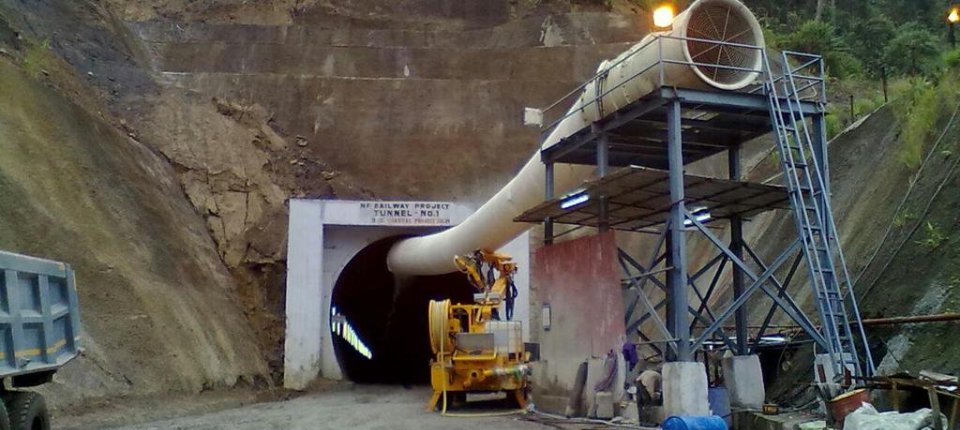
(2) Mizoram: The project of BG line connectivity from Bhairabi to Sairang (51.38 km) (suburban city of Aizawl, the Capital city of Mizoram) in Mizoram was sanctioned in 2008-09. The latest anticipated cost of the project is ₹5,021.45 crore and the land could be made available in 2014-15 and work speeded up from 2015-16 & the expenditure of ₹2,671.85 crore has been incurred on the project upto March, 2019.
The construction work has been taken up throughout the length of project and 87% tunneling work has been completed and the work on 6 tall bridges has been taken up.
(3) Nagaland: The project of BG line connectivity from Dimapur (Dhansiri) – Zubza (Kohima) (82.50 km) (suburban city of Kohima, the Capital city of Nagaland) in Nagaland was sanctioned in 2006-07. The latest anticipated cost of the project is ₹3,000 crore and the work speeded up from September, 2018 and the expenditure of ₹729.89 crore has been incurred on the project upto March, 2019.
The construction work has been taken up throughout the length of project. For complete commission of the project, the work of acquiring balance land in 8 km length has been taken up (ownership disputes). Target for completion for complete project is 3 years after complete land is handed over to Railways.

(4) Meghalaya: Two projects of BG line have been taken up for Capital connectivity of Meghalaya.
- New BG line from Tetelia – Byrnihat (21.50 km) in Meghalaya was sanctioned in 2006-07. The latest anticipated cost of the project is ₹1,532 crore and the work speeded up from 2014-15, 10 km length of the project falling in Assam State from Tetelia to Kamalajari got completed in October, 2018 and expenditure of ₹581.32 crore has been incurred upto March, 2019. Some organization is stating that a railway connectivity may lead to influx of outsiders and this has led to local resistance to this project in Meghalaya. Target for complete project is 2 years after complete land is physically handed over to Railways.
- New BG line from Byrnihat to Shillong (108.40 km) was sanctioned in 2010-11. The latest anticipated cost of the project is ₹6,000 crore and the expenditure of ₹261.03 crore has been incurred on the project up to March, 2019. Some organization is stating that a railway connectivity may lead to influx of outsiders and this has led to local resistance to this project in Meghalaya. Final Location Survey has not been allowed (by local people) to be conducted in around 5 km length and also not allowing to fix center line pillars in alignment. Hence, target for completion not fixed, as the same would be decided, once the entire land is physically handed over to Railways.
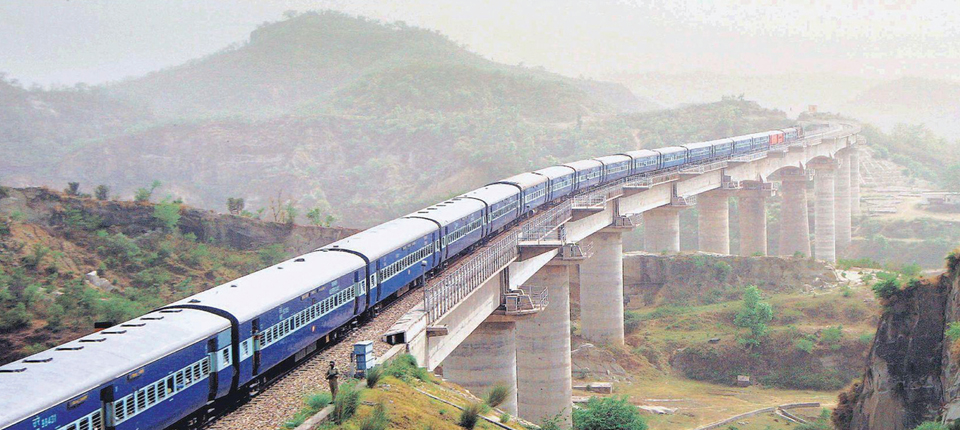
(5) Sikkim: The project of BG line connectivity from Sivok to Rangpo (44.39 km) was sanctioned in 2008-09. The latest anticipated cost of the project is ₹4,085.69 crore and the expenditure of ₹645.77 crore has been incurred on the project upto March, 2019.
The project suffered on account of delay in handing over of encumbrance free forest land by Government of West Bengal. However, now the work has been started on the land handed over so far. Still 26 structures falling in Railway alignment need to be shifted by Government of West Bengal, which is hampering the progress of work. Target for completion of complete project is 3 years after complete physical possession of land is given to Railways.
10. Eastern and Western Dedicated Freight Corridors:
Eastern Dedicated Freight Corridor (EDFC) is from Ludhiana to Dankuni (1318 Kms Ludhiana to Sonnagar and 538 Kms Sonnagar to Dankuni) and Western Dedicated Freight Corridor (WDFC) is from Jawaharlal Nehru Port Terminal (JNPT) to Dadri (1504 Kms);
Western DFC passes through States of Uttar Pradesh, Haryana, Rajasthan, Gujarat and Maharashtra and Eastern DFC through States of Punjab, Haryana, Uttar Pradesh, Bihar, Jharkhand and West Bengal. Both EDFC and WDFCs are targeted for commissioning in phases by year 2022.

Some of the salient features of Dedicated Freight Corridor (DFC) Project are as:-
- Designed for a maximum speed of 100 Kmph;
- Substructure designed for an axle load of 32.5 tons and superstructure with axle load of 25 tons; and
- Capacity to run long haul train of 1500 meter length.
The project faced some difficulties usually faced in execution of any Railway project such as delay in land acquisition, resistance by Project-affected Persons (PAP) and environmental/forest clearance. These are resolved by constant interaction with and assistance from concerned agencies and the State Governments.
The Eastern Dedicated Freight Corridor with a route length of 1856 km consists of two distinct segments: an electrified double-track segment of 1409 km between Dankuni in West Bengal & Khurja in Uttar Pradesh & an electrified single-track segment of 447 km between Ludhiana (Dhandari Kalan) – Khurja – Dadri in the state of Punjab, Haryana and Uttar Pradesh. The Western Dedicated Freight Corridor covers a distance of 1504 km of double line electric (2 X 25 KV) track from JNPT to Dadri via Vadodara-Ahmedabad-Palanpur-Phulera-Rewari.
CONCLUSION: Indian Railways (IR) run 9,212 freight and 13,313 passenger trains over its network of 66,687 Route Kilometers (RKM) and carries more than 1,000 million tonnes of freight traffic per year and about 22 million passengers every day. Ministry of Railways has taken new initiatives for accelerating the pace of the Railway projects. Indian Railways is investing heavily in its infrastructure. The Indian Railways plans to invest USD 700 billion through partnerships, joint ventures and collaborations to strengthen the infrastructure and reach the farthest corners of the country in the next 12 years.

